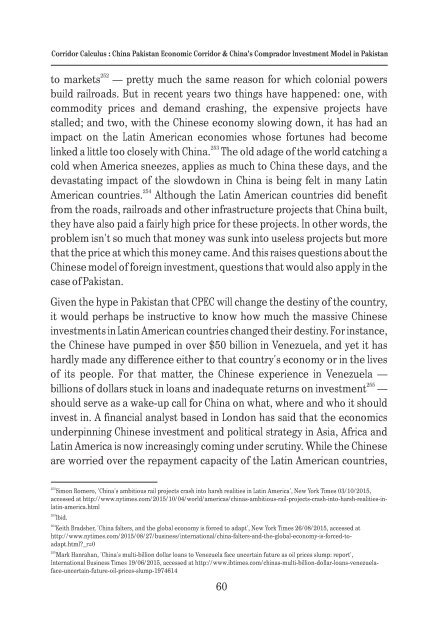Corridor Calculus
corridor-calculus-china-pakistan-economic-corridor-and-china-s-comprador-investment-model-in-pakistan
corridor-calculus-china-pakistan-economic-corridor-and-china-s-comprador-investment-model-in-pakistan
You also want an ePaper? Increase the reach of your titles
YUMPU automatically turns print PDFs into web optimized ePapers that Google loves.
<strong>Corridor</strong> <strong>Calculus</strong> : China Pakistan Economic <strong>Corridor</strong> & China's Comprador Investment Model in Pakistan<br />
252<br />
to markets — pretty much the same reason for which colonial powers<br />
build railroads. But in recent years two things have happened: one, with<br />
commodity prices and demand crashing, the expensive projects have<br />
stalled; and two, with the Chinese economy slowing down, it has had an<br />
impact on the Latin American economies whose fortunes had become<br />
253<br />
linked a little too closely with China. The old adage of the world catching a<br />
cold when America sneezes, applies as much to China these days, and the<br />
devastating impact of the slowdown in China is being felt in many Latin<br />
254<br />
American countries. Although the Latin American countries did benefit<br />
from the roads, railroads and other infrastructure projects that China built,<br />
they have also paid a fairly high price for these projects. In other words, the<br />
problem isn't so much that money was sunk into useless projects but more<br />
that the price at which this money came. And this raises questions about the<br />
Chinese model of foreign investment, questions that would also apply in the<br />
case of Pakistan.<br />
Given the hype in Pakistan that CPEC will change the destiny of the country,<br />
it would perhaps be instructive to know how much the massive Chinese<br />
investments in Latin American countries changed their destiny. For instance,<br />
the Chinese have pumped in over $50 billion in Venezuela, and yet it has<br />
hardly made any difference either to that country's economy or in the lives<br />
of its people. For that matter, the Chinese experience in Venezuela —<br />
255<br />
billions of dollars stuck in loans and inadequate returns on investment —<br />
should serve as a wake-up call for China on what, where and who it should<br />
invest in. A financial analyst based in London has said that the economics<br />
underpinning Chinese investment and political strategy in Asia, Africa and<br />
Latin America is now increasingly coming under scrutiny. While the Chinese<br />
are worried over the repayment capacity of the Latin American countries,<br />
252<br />
Simon Romero, 'China's ambitious rail projects crash into harsh realities in Latin America', New York Times 03/10/2015,<br />
accessed at http://www.nytimes.com/2015/10/04/world/americas/chinas-ambitious-rail-projects-crash-into-harsh-realities-inlatin-america.html<br />
253<br />
Ibid.<br />
254<br />
Keith Bradsher, 'China falters, and the global economy is forced to adapt', New York Times 26/08/2015, accessed at<br />
http://www.nytimes.com/2015/08/27/business/international/china-falters-and-the-global-economy-is-forced-toadapt.html?_r=0<br />
255<br />
Mark Hanrahan, 'China's multi-billion dollar loans to Venezuela face uncertain future as oil prices slump: report',<br />
International Business Times 19/06/2015, accessed at http://www.ibtimes.com/chinas-multi-billion-dollar-loans-venezuelaface-uncertain-future-oil-prices-slump-1974614<br />
60


